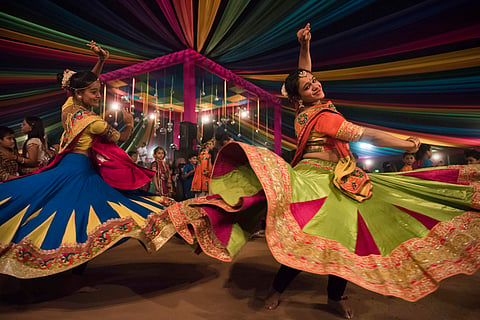
- Destinations
- Experiences
- Stay
- What's new
- Celebrating People
- Responsible Tourism
- CampaignsCampaigns
- Subscribe
- Buy Now

For the millions of Indians living abroad, the nine nights dedicated to Maa Durga are a profound way to reconnect. It’s a time when you stop being an expat or an immigrant and simply become home. Thanks to the diaspora, you don't need a flight to Ahmedabad to find that magic. Across the globe, these five destinations have taken the spirit of the festival and made it their own, blending tradition with their unique local flair.
If you're looking for the purest, most energetic slice of a Gujarati garba experience outside of India, you must land in New Jersey. Forget reserved community halls around Newark Avenue, the celebration literally spills onto the streets.
For several nights, this area, affectionately called 'Little India,' becomes a pedestrian-only zone, a vast, swirling dance floor under the cool autumn sky. The feeling here is massive and uninhibited. You’ll be shoulder-to-shoulder with 15,000 strangers and feel like family. The ghagra cholis and kediyus are blindingly bright, the tempo is relentless, and the exhaustion at 2 am is deeply satisfying. After dancing till you drop, the best part might be stumbling upon a food stall serving piping-hot fafda-jalebi right next to a New Jersey hot dog stand, a truly American-Indian moment.
Outlook Traveller Tip: The street Garba is free, but wear comfortable juttis. Larger, celebrity-hosted events nearby are ticketed, so plan your nights based on your budget and preferred energy level.
The UK’s Navratri is a testament to the community's deep roots. While London’s Wembley and Harrow offer grand events, the true heart of the celebration beats in Leicester. Its Navratri is famously one of the largest in Europe.
Imagine a sports arena or a massive community centre completely transformed, not for a concert, but for a spiritual dance marathon. The focus is often on the incredible endurance of the dancers, some of whom move for six hours straight. The energy here is refined but intense. Crucially, the UK embraces both the high-octane dandiya-raas and the solemn artistry of Durga Puja. You can transition from a stick-clashing frenzy one night to visiting an elaborately decorated Pandal where the Durga idol is a masterpiece of art and devotion.
Outlook Traveller Tip: Mix it up: after a Garba night, visit a Bengali Durga Puja Pandal in London. Attend during bhog time to experience the traditional, shared, blessed community meal.
Everything in Dubai is grand, and Navratri is no exception. This city caters to the global Indian elite, meaning the celebrations are often held in the opulent ballrooms of five-star hotels or vast convention halls.
The atmosphere is one of high-fashion and celebrity. People don’t just dress up; they glam up, showcasing incredible bespoke Indian wear. Live music is a given, often featuring famous playback singers flown in from Mumbai or Ahmedabad, turning the dance floor into a Bollywood-style spectacle. It’s less grassroots and more global-stage, but the devotion and the sheer joy of dancing with thousands of others is very real. It's the perfect mix of ancestral tradition set against a hyper-modern, cosmopolitan backdrop.
Outlook Traveller Tip: While the ballroom dress code is high-glam Indian wear, remember to keep your attire modest (shoulders and knees covered) when entering and leaving the hotel premises or moving through public areas.
In the meticulous island city-state of Singapore, Navratri offers a beautiful contrast between the quiet devotion of the South and the boisterous energy of the North.
For the South Indian community, the heart of the festival is often found within homes, in the intricate setup of the Golu. These multi-tiered displays of dolls, depicting scenes from mythology and daily life, feel like miniature temples. Visiting a home during this time is an intimate, beautiful experience, exchanging sweets and singing devotional songs. Meanwhile, the North Indian diaspora keeps the rhythm alive with large, organised dandiya nights in venues around Little India, making sure the air crackles with the sound of clashing sticks and folk music. It’s a wonderful place to feel the diverse threads of Indian culture woven together.
Outlook Traveller Tip: If invited to a home to see the Golu, bring a small token like fruit, sweets, or flowers. Accept the prasadam and dress in clean, conservative attire as a sign of respect for the devotional space.
Perhaps the most surprising and rewarding place to find Navratri's soul is in East Africa. Kenya has one of the oldest Indian communities outside the subcontinent, and their traditions are deeply ingrained.
In Nairobi and Mombasa, the local Hindu temples serve as the unpretentious, beating heart of the festival. Here, the energy is wonderfully grounded and authentic. What truly sets it apart is the subtle fusion of rhythms. When the Garbamusic plays, you can sometimes hear the distinct, powerful undertones of African percussion weaving through the traditional beats. It’s an organic cultural dialogue, a celebration of Maa Durga that feels connected to the land, an ancient Indian tradition happily settling into a centuries-old African home.
Outlook Traveller Tip: Skip the standard fast food and try the local Kenyan-Indian fusion snacks sold near the temple venues, like the famous pili-pili potato vadas or the simple, spiced daal-bhajia.
